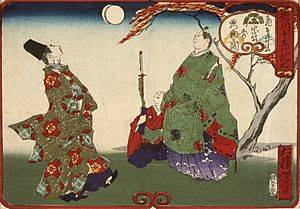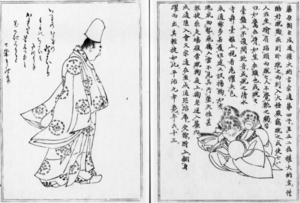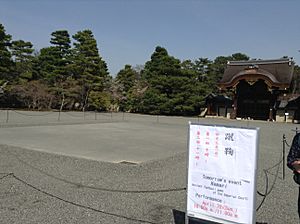Kemari facts for kids

Kemari (蹴鞠) is an old Japanese game. It was very popular during the Heian period (794–1185) and Kamakura period (1185–1333). Think of it like a game of keepie uppie or hacky sack. The goal is to keep a ball in the air using only your feet. Kemari started with the rich nobles in Kyoto. Over time, it became popular with samurai and even common people. Today, Kemari is played as a special event. You can often see it at Shinto shrines in the Kansai region of Japan. Players wear special clothes called kariginu. These were once worn by nobles long ago.
Contents
History of Kemari
How Kemari Began
Kemari was inspired by an old Chinese sport called cuju. Both games use the same kanji characters. Some say Kemari was first played in Japan around 644 CE. This idea comes from a record in the Nihon Shoki. It talks about Prince Naka-no-Ōe and Nakatomi no Kamatari playing a ball game. However, some historians think this game might have been more like hockey.
The first clear mention of Kemari (蹴鞠) is from a record called Honchō gatsuryo. This book was written in the middle of the Heian period. It says that Kemari games were played as early as May 701.
Kemari's Golden Age
Kemari became very popular with the nobles in the late Heian period (around the 11th century). By the 12th century, some players became famous. Fujiwara no Narimichi and Nanba Yorisuke were known as masters of the game. Fujiwara no Narimichi even visited the Kumano Hongū Taisha shrine over 50 times. He prayed there to get better at Kemari. He was known for a special move called ushiro mari. This was a keepie uppie done using the heel of the foot.
The game was most popular between the late 12th century and the 13th century. This was during the early Kamakura period (1185–1333). Kemari games were often played when Minamoto no Yoriie was in charge. During this time, new rules, equipment, and ways of playing were created. It became a structured art form called kemaridō.
Kemari and the Samurai
In the Kamakura period, Kemari also became popular among the samurai class. Later, in the Muromachi period (1336–1573), Kemari was seen as an important skill. Samurai were encouraged to learn it. It was grouped with other arts like waka (Japanese poetry) and the Japanese tea ceremony.
Decline and Revival
During the Sengoku period (1467–1615), sumo wrestling became more popular. This caused Kemari to decline. But in the Edo period (1683–1868), Kemari became popular again. This time, it was played by common people, called chōnin, especially in the Kansai region.
In the past, nobles in Kyoto played Kemari every year on January 4th. Later, Emperor Meiji worried that Japan's old traditions might be lost. So, in 1903, he helped start a group to keep Kemari alive. He even gave money to support it.
Today, Kemari is played as a special event at many Shinto shrines. You can see it at places like Shimogamo Shrine, Shiramine Jingū, and Tanzan Shrine. There is even a god of the Kemari ball. This god, Seidaimyōjin, is honored at Shiramine Shrine. Because of this, players of many ball games, especially association football, respect this shrine.
Did you know that George H. W. Bush played Kemari? He tried the game during one of his visits to Japan as president.
How Kemari is Played
The Game and Players
Kemari is a non-competitive sport. This means players work together, not against each other. The main goal is to keep one ball in the air for as long as possible. Players can use any part of their body except their arms and hands. They can use their head, feet, knees, or back. Some rules even allow elbows.
The person who kicks the ball is called a mariashi. A good mariashi makes it easy for the next player to control the ball. They kick it gently so it stays in the air easily.
The Mari Ball and Field
The ball used in Kemari is called a mari. It is made from deerskin. The soft hair side faces inside, and the smooth hide is on the outside. To give it shape, the ball is first filled with barley grains. Once the hide holds its shape, the grains are removed. Then, the ball is sewn together using horse skin.
Kemari is played on a flat area. This area is usually about 6 to 7 meters (about 20 to 23 feet) square. The clothes modern players wear look like those from the Heian period. They include a special crow hat. This type of clothing was called kariginu and was very stylish back then.




